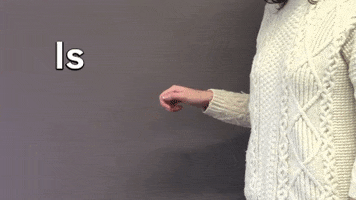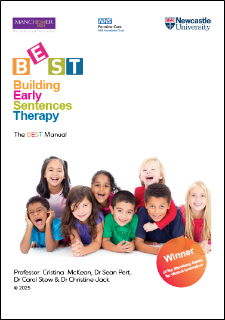Delivering BEST
Signing
BEST uses a combination of Makaton and Paget Gorman Signed Speech (PGSS). Signing is recommended as a supporting visual model of the structure being presented to the children. It is a proven active ingredient of the intervention. It is optional and the therapy can still be carried out without using signs.
Makaton is used for content words (nouns and verbs) and Paget Gorman is used for grammatical words/grammatical markers (e.g. the / a / -ing). Videos of the Paget Gorman signs can be found below. For Makaton signs you can visit: https://makaton.org/
Morphology Signs (PGSS):







Toys
The therapy sessions involve various sets of toys which are fairly common and easy to find. Below you can find which toys are in each set.
Sets A1 and A2
Dolls: Baby, woman/lady, man, boy, girl, teddy
Chair (Optional for ‘sitting’)

Sets B1 and B2
Dolls: Baby, woman/lady, man, boy, girl, teddy (from Set A)

Sets C1 and C2
Dolls: Man, teddy (from Set A)
Apple, orange, banana, carrot, lolly, spoon, cup, sponge (for washing).

Sets D1 and D2
Dolls: Boy, baby (from Set A)
Cat, horse, bike, apple, flower, orange, banana, sock, carrot.

Sets E1 and E2
Dolls: Boy, girl, baby, teddy (from Set A)
Cat, horse.

Sets F1 and F2
Dolls: Girl, woman/lady, teddy (from Set A)
Apple, orange, ball, cup, train, shoe, cat, brush, horse.

Sets G1 and G2
Dolls: Baby, man (from Set A)
Table, Bed, Spoon, cup, flower, key, (mobile/cell) ‘phone.

Sets H1 and H2
Dolls: Man, baby (from Set A)
Cup, shoe, box, milk, juice (empty and clean cartons/bottles or toys).

Sets I1 and I2
Dolls: Man, baby
Bed, cup, box, shoe
Spoon, cup, flower, key, (mobile/cell) ‘phone, juice (empty and clean carton/bottle or toy).

Sets J1 and J2
Dolls: Girl, baby, boy, woman/lady (from Set A)
Ball, banana, (mobile/cell) ‘phone, lolly, apple.
Sets K
Dolls: Baby, woman/lady, man, girl (from Set A)
Ball, banana

Sets L
Dolls: Girl, woman/lady, man, baby (from Set A)
Apple, ball, banana, lolly, (mobile/cell) 'phone.

For more information and a printable version of this list:
All resouces are published under a Creative Commons Licence: BY-NC-ND.
You can use and share the materials as long as you give credit to the LIVELY team at Newcastle University. You may not use the materials for commercial purposes. If you make changes to the materials you may not share these.








